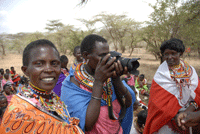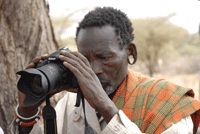Indigenous Community goes Digital with High-Tech Support from WIPO
Geneva,
August 5, 2009
PR/2009/599

Ms. Florence Tampushi, Ms. Ngoto Koisani, Ms. Kashui Maiyani, take part in ceremony. (© Guha Shankar, AFC/LoC)
In a community ceremony, under the shade of an acacia tree, the World Intellectual Property Organization (WIPO) formally handed over digital recording equipment to Chief Kisio and other elders of the Maasai community, at Il Ngwesi, Laikipia, Kenya to assist the Maasai people in preserving and documenting their rich cultural heritage. Some 200 members of the community participated in the ceremony in late July.
This marked a milestone in a pilot program initiated by WIPO to help indigenous communities document and preserve their own cultural traditions while simultaneously managing their intellectual property interests.
New technologies provide these communities with fresh opportunities to document and digitize expressions of their traditional cultures. Yet, these new forms of documentation and digitization can leave this cultural heritage vulnerable to unwanted exploitation beyond the traditional circle. By empowering the community to record its own traditions and creative expressions, the program allows the community to create its own intellectual property in the form of photographs, sound recordings and databases.
The IP training component of the program enables the community to make informed decisions about how to manage intellectual property assets in a way that corresponds with its values and development goals.

Mr. Ole Keshine tests new camera (© Guha Shankar, AFC/LoC)
The program also stimulates creativity within the community, can promote local economic and cultural development and helps to bridge the “digital divide”, key objectives of both the Millennium Development Goals and WIPO’s Development Agenda.
The training program enables the Maasai to acquire the requisite technical skills and provides the necessary equipment to document and digitize their cultural heritage on an on-going basis. The equipment provided to the community by WIPO includes a digital camera and sound recording equipment, as well as a state of the art laptop. WIPO will continue to provide ongoing IP advice and support to the community.
The training program is offered by WIPO, in partnership with the American Folklife Center at the Library of Congress and the Center for Documentary Studies at Duke University in the United States of America. The National Museums of Kenya also participated in the program offered to the Kenyan Maasai community.
This pilot is part of WIPO’s Creative Heritage Project, which is developing an integrated set of practical resources and guidelines for cultural institutions such as museums and indigenous communities on managing intellectual property options when digitizing intangible cultural heritage.
Related Links
- http://www.reuters.com/article/internetNews/idUSTRE56S64G20090729
- http://www.grammy.com/GRAMMY_Awards/News/Default.aspx?newsID=3465&newsCategoryID=5
- http://www.scoop.co.nz/stories/WO0908/S00107.htm
- Tel: (+41 22) 338 81 61 / 338 72 24